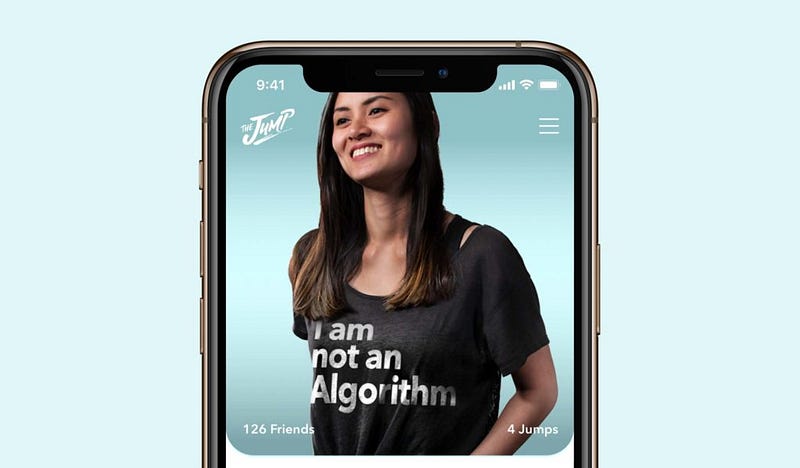Is it possible for a social media platform to be healthy? With so many social media options out there, it can be difficult to stay focused on what really matters— connecting with others. If you’re like me, someone who misses bonding with real friends and real interests, then stick around to see how some platforms like The Jump, are discovering new, healthier ways to use social media. Here are 5 ways that might help you:
1. Time well spent
Most platforms make money by sucking up your time with ads and distractions. The longer you spend on their apps, the more money they make selling digital ads. And what’s more is you’re probably so used to scrolling, you no longer realize how much energy it takes just to process everything you’re looking at.
Check out your Facebook and Instagram feeds. One out of every five posts will be an ad. It’s a formula and it’s keeping you from the things you actually came for — to connect with the people and interests you care about.
So, let’s stop all that. Let’s imagine a place where your feeds are free of ads and you’ll see your friends’ posts every time. Because why should an algorithm decide which updates and friend posts actually matter to you?
2. Power of positivity
There’s an old news media adage: ‘If it bleeds, it leads.’ On many platforms the most outlandish, polarizing stories are the ones that illicit the most comments, clicks and shares, so the algorithm prioritizes those posts over others.
That means, when you sign on to send your friend a cheerful Happy Birthday message, you’re forced to wade through divisive politics, angry rants and depressing posts, too. Who needs that emotional rollercoaster? It’s just exhausting.
Negativity should not be rewarded by helping it go viral. Sure, a friend might post an article that’s depressing or contentious, but it shouldn’t be the norm and there shouldn’t be mechanisms in place that facilitate virality. Platforms need to believe that if they stop celebrating negative behavior, they can cultivate an ecosystem that values positivity, first and foremost.
They can cultivate an ecosystem that values positivity
3. Your data is yours
You’re a person, not a revenue stream. Your data isn’t there to be sold and your information is not prey just to make a buck. That means, you can rest easy knowing someone won’t eavesdrop on your conversations or inundate you with ads for that vacuum you looked at last week.
But I know what you’re thinking — that’s great, but how would a platform actually make money? Well, it won’t be by selling you out, because a smart revenue model doesn’t require it. Back in the good ole’ days, TV shows used to partner with your favorite brands to produce shows that you loved. What if social media did the same? A platform that partners with cool brands and interesting creators to produce content you’ll actually want to see, content so cool you actually seek it out. (Think unique experiences, engaging tutorials and exclusive partnerships.)
Honestly, digital advertising is due for an overhaul anyway. Every year, brands drop $130 billion on ads and statistics show they don’t make much of an impact. So, there’s a chance that while changing the face of social media, you could take on the advertising industry, too.

4. Focus on connection
Even if I don’t love Facebook, I’ll be the first to tell you that it’s not all bad. The parts about connecting friends and family? That’s the good stuff, but it’s hard to see all that when the negative aspects are so prevalent.
If we call it SOCIAL media, connection needs to be at the forefront. Platforms should always be looking for ways to enrich communication, rather than distract from it. That means focusing on more ways for friends to share updates with other friends and expanding functionality to support the group experience.
By bringing so many tools together (think signups, podcasts, events, checklists, file storage, just to name a few) you’d be able to unite communities in a way that others can’t. On the ideal app, discussions are engaging, resources are organized and groups of all sizes are able to collaborate effectively and efficiently.
5. You’re in control
I like to think user-driven customization is key to delivering a better social media experience. You could opt out of updates from users and hide posts from your newsfeed, but that’s just the beginning. Maybe you need updates from someone in one group, but don’t want to hear from them in another? You could have the tools to mix and match which updates you get.
And if you don’t like newsfeeds, no problem. Imagine if you can turn it off entirely. Depressed by all the Covid-19 news? An app could have a built-in feed filter that allows you to automatically remove posts based off any mix of keywords you select.
Finally, in addition to being able to filter your feed based off all posts, friend’s posts and group posts, imagine being able to create a custom feed with specific friends and groups included. Now that’s what I consider to be truly social.
I know. I know. All 5 of these sound way too good to be true. But there are healthier alternatives out there. One that comes to mind is The Jump and it’s free – even free of algorithms. It is exactly the type of overhaul that social media needs today.


